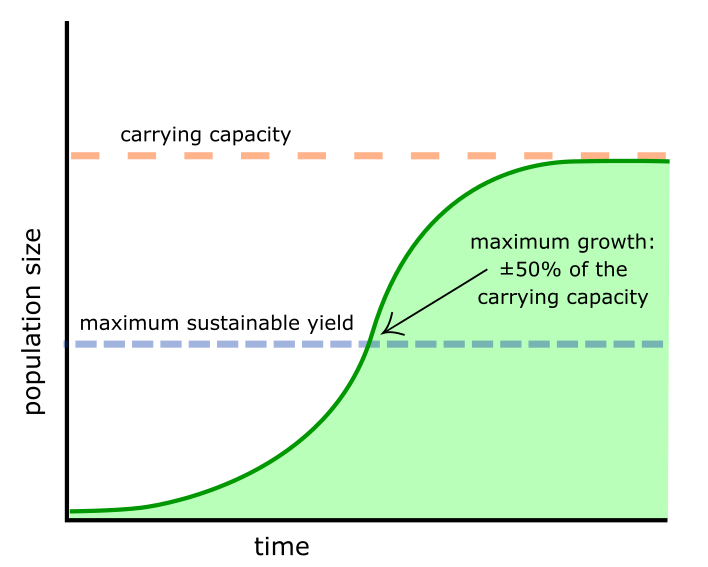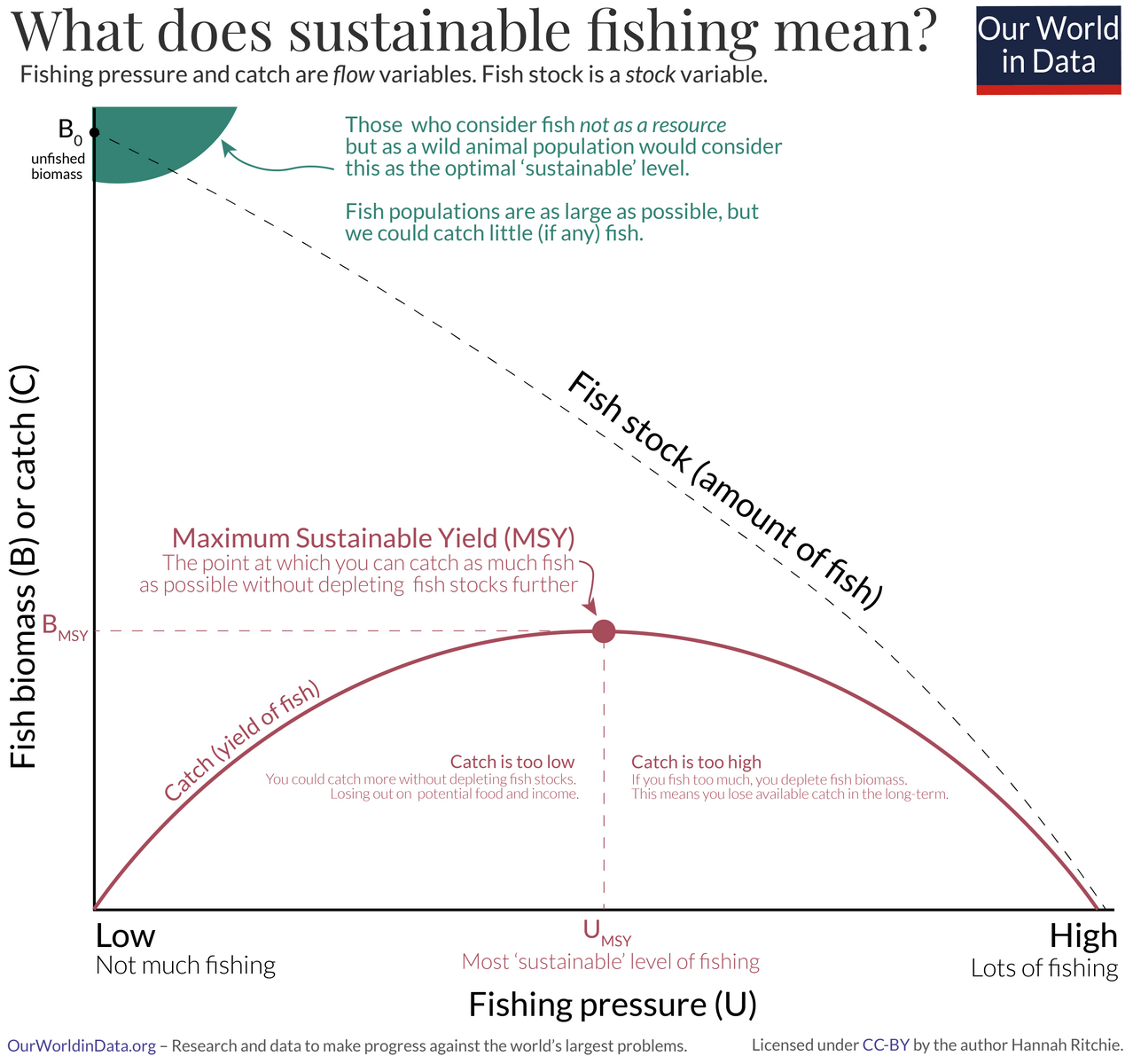IB Syllabus focus:
‘MSY is the highest long-term catch; quotas should reflect lower fishing effort than typical. Use yield–effort curves to set caps.’
The concept of Maximum Sustainable Yield (MSY) is a critical management tool in fisheries and aquatic resource systems, aiming to balance ecological sustainability with human consumption demands.
Understanding Maximum Sustainable Yield
Definition of MSY
Maximum Sustainable Yield (MSY): The largest average catch that can be continuously taken from a fish population under existing environmental conditions without depleting the stock.
MSY provides a guideline for sustainable harvesting, ensuring that populations remain productive while still meeting human needs. It is based on the assumption that fish populations grow in a way that allows for consistent renewal if harvesting remains below a certain threshold.
Biological Basis of MSY
MSY is grounded in population dynamics, particularly the balance between recruitment (new individuals entering the population) and mortality (death from natural causes and harvesting).
At low population sizes, growth is restricted due to fewer breeding individuals.
At high population sizes, density-dependent factors (competition for food, space, and oxygen) reduce growth rates.
MSY occurs at the point where population growth is maximised, typically at about half the carrying capacity (K/2) of the ecosystem.
Population Growth Model
Logistic Growth Equation (dN/dt) = rN(1 – N/K)
dN/dt = rate of population growth
r = intrinsic rate of increase (per year)
N = population size (number of individuals)
K = carrying capacity (maximum sustainable population size)
This model demonstrates that the fastest growth rate—and thus the maximum harvest—occurs when the population size is approximately 50% of carrying capacity.

Logistic growth of a renewable resource with the carrying capacity (K) and the maximum sustainable yield (MSY) indicated. Growth peaks near K/2, where removals can be sustained in the long term. This aligns with the logistic model underpinning MSY in fisheries. Source.
Yield–Effort Curves
Understanding the Relationship
The yield–effort curve visually represents the relationship between fishing effort and the resulting catch:
At low levels of fishing effort, yields increase steeply.
At moderate effort, yield continues to rise but begins to slow as the population approaches its sustainable harvesting threshold.
At excessive effort, yield declines as overfishing reduces population size, sometimes leading to stock collapse.
Importance for Management
MSY is located at the peak of this curve, where yield is maximised without depleting resources. If effort exceeds this point, unsustainable harvesting occurs. Fisheries managers use this principle to set quotas, seasons, and gear restrictions.

Dome-shaped yield–effort relationship illustrating the maximum sustainable yield (MSY) at the curve’s peak. Increasing effort beyond this point reduces yield and risks stock decline. Axes and labels match how managers read effort vs. yield when setting quotas. Source.
Applications of MSY in Fisheries
Management Tools
To align with MSY principles, fisheries often implement:
Catch quotas: Limiting the amount of fish harvested.
Fishing seasons: Restricting harvest to times when stocks can recover.
Gear restrictions: Avoiding methods like trawling that cause high bycatch or habitat destruction.
Protected areas: Establishing Marine Protected Areas (MPAs) where harvesting is reduced or prohibited.
Quotas and Effort Regulation
Quota: A legally enforced limit on the amount of fish or aquatic organisms that can be caught within a defined period.
Quotas are designed to reflect less effort than typical harvesting levels, ensuring populations remain viable. Overestimating MSY can result in fishery collapses.
Limitations and Criticisms of MSY
Assumptions
MSY assumes:
Population dynamics are stable and predictable.
Environmental conditions remain constant.
There is complete knowledge of stock size and growth rates.
In reality, ecosystems are highly dynamic, influenced by climate change, pollution, invasive species, and changing predator–prey relationships.
Risks of Overexploitation
When MSY is set inaccurately:
Fisheries may exceed safe harvesting levels.
Stocks may collapse (e.g., the Grand Banks cod fishery).
Ecological imbalance occurs, disrupting food webs.
Alternatives and Improvements
Modern approaches often move beyond MSY, incorporating:
Precautionary principle: Harvesting well below estimated MSY.
Ecosystem-based management: Considering wider ecological interactions.
Adaptive management: Continuously adjusting strategies based on monitoring data.
Sustainable Harvesting Strategies
Determining Sustainable Rates
Sustainable Harvest Rate (H) = Population Growth (dN/dt) at K/2
H = Maximum level of harvest that can occur without reducing long-term population viability
This equation highlights the balance between population renewal and removal. Managers can use input–output flow diagrams for aquatic systems to calculate whether harvesting remains within sustainable limits.
Practical Approaches
Sustainable harvesting informed by MSY requires:
Continuous monitoring of stock levels.
Application of scientific models to estimate safe yields.
Regular review of quotas in response to ecological and social changes.
Role of International Agreements
Global initiatives, such as those led by the Food and Agriculture Organization (FAO), promote MSY principles to reduce overfishing and protect shared resources like international waters.
Conclusion in Practice
MSY remains a cornerstone of aquatic resource management, guiding how societies regulate fishing effort. Its emphasis on long-term balance between harvest and renewal ensures that human needs are met without undermining the ecosystems upon which they depend.
FAQ
MSY is not fixed; it shifts with environmental changes. Variations in temperature, nutrient levels, or predator–prey dynamics can alter carrying capacity and growth rates.
For instance, warming seas may reduce oxygen availability and limit reproduction, while pollution can lower food supply. Such shifts mean that a previously sustainable harvest could suddenly become unsustainable.
MSY focuses on single species, yet ecosystems are interconnected. Harvesting one stock at MSY may reduce prey for predators or disrupt food webs.
This limitation highlights the importance of ecosystem-based management, which accounts for predator–prey dynamics, habitat quality, and biodiversity alongside yield calculations.
Direct counts of fish stocks are rare. Scientists use sampling methods such as trawl surveys, acoustic monitoring, and tagging studies to estimate population size and growth.
They also apply mathematical models, often informed by catch-per-unit-effort (CPUE) data, to approximate stock dynamics. These models introduce uncertainty but provide the best available basis for setting MSY.
Historical data may overestimate productivity if stocks were already depleted when records began. In such cases, MSY could be set above true sustainable limits.
Shifts in fishing technology, effort, and reporting accuracy also distort trends. Reliance on flawed baselines risks reinforcing overexploitation rather than preventing it.
Managers can apply a precautionary approach, setting quotas below traditional MSY estimates.
They may also adopt adaptive management:
Regular stock assessments
Incorporating climate models into forecasts
Adjusting MSY targets in response to warming seas, acidification, and habitat loss
These adaptations ensure that harvests remain sustainable in dynamic environmental conditions.
Practice Questions
Question 1 (2 marks)
Define Maximum Sustainable Yield (MSY) and explain at what point in population growth it occurs.
Mark scheme:
Definition of MSY: The largest average catch that can be taken continuously without depleting the stock. (1 mark)
Occurs at around half the carrying capacity (K/2), where population growth rate is at its maximum. (1 mark)
Question 2 (5 marks)
Using the concept of the yield–effort curve, explain how MSY is applied in fisheries management and discuss two limitations of using MSY as a management tool.
Mark scheme:
Yield–effort curve shows relationship between fishing effort and yield, with MSY at the peak. (1 mark)
Managers set quotas, seasons, or effort limits to keep harvesting at or below MSY. (1 mark)
Limitation 1: Assumes stable and predictable population dynamics/environmental conditions. (1 mark)
Limitation 2: Risk of stock collapse if MSY is set inaccurately or environmental changes occur. (1 mark)
Additional valid limitation (e.g., incomplete data, ignoring ecosystem interactions) accepted. (1 mark)

